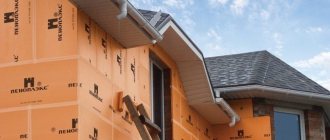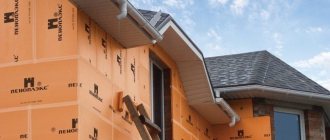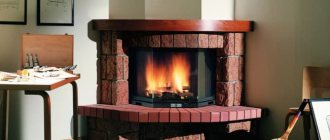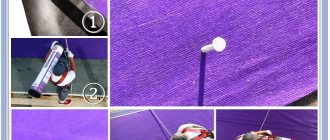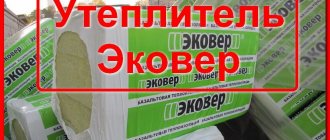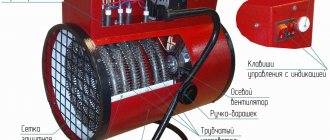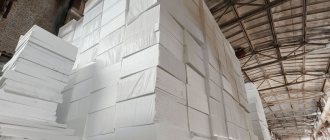To insulate the premises of construction sites, pipelines, ventilation ducts of engineering communications, both flammable and non-flammable insulation materials of various types are used.
The definition of non-flammable fire-resistant insulation is given by GOST 30244-94, which indicates that such a material, when exposed to an ignition source, burns with an open fire for no more than 10 s, and when tested in a laboratory oven loses no more than 50% of its mass, creating a temperature increase in it of no more than 50 ℃.
All insulation materials that do not satisfy at least one of the listed conditions are classified as flammable, non-fire-resistant materials.
Types of Fire Resistant Thermal Insulation Products
Kinds
Unlike combustible types of insulation, such as sawdust, mats made from wood processing waste, used due to their rapid destruction under the influence of moisture only inside buildings, many types of fire-resistant thermal insulation materials are also used when installing curtain wall systems, in external wall panels outside construction sites.
On this topic ▼
Non-flammable substances and materials
Classification and applications
There are several main types of fire-resistant insulation, divided depending on their area of application:
- For walls , floors of both wooden houses and construction sites built from brick, ceramic blocks, ready-made reinforced concrete, monolithic structures, including those made of fire-resistant (fire-resistant) concrete. In such cases, both traditional mineral wool and more modern fire-retardant basalt material, which does not absorb moisture and is non-flammable, are used in the form of rolls, mats, and slabs.
- For chimneys non-flammable foil material made from various types of mineral wool is most often used And also due to the increased density of non-flammable insulation, used for these purposes as filling the thermal insulation areas of the floors adjacent to the chimneys; elements of fire-fighting cuttings, indentation.
- For thermal insulation , fire protection of metal structures of ventilation air ducts; sections of pipeline networks, both transporting coolants, including water, and flammable liquids, gas mixtures.
- For an engine , motor vehicle, railway vehicle, river/sea vessel/ship, stationary heat-generating, electricity-generating installations, both to limit the consumption of thermal energy, heating of adjacent structures, compartments, and as a reliable sound insulation, cutting off loud noise from operating machines and mechanisms.
- For filling internal voids in the construction of fire partitions, fire-resistant gates, doors, hatches, used to protect openings in construction barriers to fire and smoke flows, which makes it possible to increase their fire resistance to the values required by fire safety standards.
This division into types is quite arbitrary, because most roll, slab, sheet fire-resistant insulation, in contrast to bulk, liquid foaming heat-insulating materials that are not subject to combustion, can be used for thermal and sound insulation of both the premises of construction sites, areas of their utility lines, and engine compartments of vehicles, heat and power generating units.
Loose thermal insulation
Vermiculite
Vermiculite is layered grains of igneous nature with a diameter from 0.25 mm to 8 mm. The mineral has a small mass, minimal thermal conductivity, and does not contain harmful components.
Given its volcanic origin, it becomes clear that vermiculite cannot be cheap. There are very few volcanoes in the country.
Good insulating qualities allow you to save money. For noticeable heat savings, it is enough to place a thin layer of minerals on the ceilings or in the cavities of the blocks.
There are pressed vermiculite slabs on sale that can be fixed to walls and ceilings using self-tapping screws. Vermiculite fire insulation tends to absorb moisture. Mineral insulation materials must be covered with a layer of waterproofing.
Perlite
Perlite is a material obtained by contact of hot magma with the surface of the earth and subsequent transformation under the influence of soil moisture.
In practice, granules of various sizes are used. Small particles with a diameter of up to 10 mm are placed on the surface of the floor, roof, and poured into the spaces between the walls.
Granules with dimensions of 1.25 mm are added to plaster and screeds. The outer layer of perlite is covered with a crust of cement mortar. Particles can be sprayed during operation, so it is advisable to install non-flammable insulation in a respirator.
Expanded clay
Expanded clay is a heat-resistant product of firing specific clay. The granules are light in weight, have a dense shell that does not deform when working with the material.
Larger particles with a diameter of 20 mm or more are placed on ceilings and wooden floors. Smaller granules are added to floor screeds and multilayer compositions for flat roofs.
Expanded clay has pores. Therefore, fireproof protection must be protected from moisture by waterproofing sheets.
Composition and properties
The main parameters of fire-resistant heat-insulating materials are:
- The material of manufacture, in most cases, determines the type of fire-resistant insulation, methods of its use at construction sites and utility lines.
- The thickness of commercial fire-resistant insulation, which depends both on the area of their application - for insulating certain types of building structures or sections of pipelines, ventilation ducts, and on the properties of the base material used for their production.
- Density, specific gravity, which determine the total load on building structures, which is often critically important for interfloor floors of residential and public buildings.
The list of main materials used in the industrial production of non-flammable, fire-resistant heat-insulating products includes the following natural, artificially obtained substances:
- Mineral wool, also called slag wool, glass wool, which is obtained from quartz sand, waste from metallurgy and energy facilities. This is the longest-used material, low cost, but requires protective equipment for workers laying it; caution when handling it due to the risk of damage to the skin, eyes, and respiratory organs.
- Basalt heat-insulating, fire-retardant material obtained by melting the natural mineral basalt, producing ultra-thin non-combustible fibers from it. The higher cost of this fire-resistant insulation is compensated by the safety of its handling and the ability to use it both inside and outside construction sites in regions of different climates, including those with high air humidity.
- Foam glass obtained by sintering a mixture of crushed glass scrap, crumbs and coal as a gas-forming agent in the production process. The resulting material is absolutely non-flammable, has a high fire resistance limit, and a low thermal conductivity coefficient. It is often used for thermal insulation of rooms with high environmental humidity, for example, basements, technical undergrounds, production areas with wet technological processes.
- Expanded clay, vermiculite, perlite - this trio of bulk materials has long been used for thermal insulation of interfloor ceilings, attics, and serves as an additive to “warm” floor screeds in residential and public buildings.
- Velite is a modern non-flammable insulation with a porous structure, which is produced from cement-lime raw materials by foaming it. In terms of structure and properties, it belongs to porous fire-resistant concrete, having a low density - up to 140 kg/m3, since up to 90% of its internal volume is air.
- Glass pore is a granular fire-resistant material obtained in the process of swelling of silicates as a result of sharp cooling of the molten sodium and potassium glasses. Most often, it is used not in the form of bulk material, but as an additive to the poured thermal insulation of interfloor ceilings of construction projects, as well as in the production of piece-piece fire-resistant thermal insulation products.
- Fire-resistant foam produced on the basis of liquid polyurethane with additives of flame retardant substances, giving it fire-retardant properties.
As you can easily see, non-flammable insulation is mainly produced on the basis of natural, artificial materials of mineral and inorganic origin, which are initially non-flammable.
On this topic ▼
Fireproof pastes
Types and order of application
Such thermal insulation products have fire safety certificates, where their combustion ability is indicated as NG, that is, non-flammable, while the vast majority of insulation products obtained at organic chemical synthesis enterprises, for example, various types of foam plastics, penoizols; “ecological wool” based on recycled cellulose secondary raw materials with additives of fire retardants are, at best, flame retardant and are marked G1.
Naturally, such insulation, despite the advertising assurances of some manufacturers and representatives of trade organizations, in no way can claim the “title” of fire-resistant insulation.
Properties additionally required by customers - designers, builders, organizations operating buildings, engineering structures, communications, which a fire-resistant non-combustible material, which is used as a fire-resistant insulation, must have:
- Low thermal conductivity, resulting in high thermal insulation parameters.
- Moisture resistance, hygroscopicity.
- The ability to reliably sound insulate walls, partitions, and ceilings that separate the protected premises.
- Safety of use, absence of release of volatile substances hazardous to humans both under normal operating conditions and under strong heating, including in the event of a fire inside a construction site where fire-resistant insulation is used for insulation and sound insulation.
- High density with relatively low specific gravity.
- Mechanical strength.
- Constancy of geometric dimensions, durability of operation without loss of fire-resistant, heat-insulating parameters.
- Low cost, which is especially important for owners and customers of the construction of private wooden houses.
- Simplicity of installation work, laying fire-resistant insulation, including without hiring third-party specialists.
Cellular materials
Cellular non-combustible insulation is similar in structure to foam. A large number of closed cavities with air causes low thermal conductivity.
Foam glass has good thermal insulating properties, which does not change for 100 years and does not absorb moisture. Foam glass, obtained by sintering broken glass with solid gas-forming agents, is used to make panels and housings for laying pipes. Foamed glass is an ideal non-flammable insulation for deep basements in wet soils.
All presented heat-insulating products have clearly expressed non-flammable properties. Thermal stability is due to mineral raw materials.
Classification
Non-flammable fire-resistant insulation is often classified according to its state of aggregation, appearance, internal structure, depending on which it can be:
- Frame , including multilayer, reinforced with non-combustible materials, often used as elements of structural fire protection of load-bearing metal structures of construction projects.
- Rolled , which allows you to wrap it around elements of building structures of various shapes and cross-sections, as well as sections of pipelines and ventilation ducts that need to be protected from freezing and possible exposure to fire in the event of a fire.
- Slab , as well as in the form of separate heat-insulating mats, specially developed by designers and manufacturers of standard sizes, which facilitates their installation and installation inside building structures, for example, partitions between rooms.
- Loose , including artificially expanded, cellular, which significantly increases its thermal insulation properties.
- Liquid foaming material that hardens during polymerization and drying after application to building structures, sections of pipeline networks, ventilation systems of protection facilities, most often called fire-resistant foam.
The choice of one or another class of non-combustible, fire-resistant insulation is determined both by design solutions and experience of use in civil and industrial construction during the construction and repair of various objects.
| Slab fire-resistant insulation | Foil fire-resistant insulation for chimneys of stove pipes |
| Stitched foil fire-resistant insulation | Fire resistant mineral wool |
When is it necessary to use non-flammable insulation materials for insulation?
There are a number of buildings that need to be insulated using non-combustible materials. This is carried out in accordance with building codes and regulations, state standards. Such buildings include:
- Gas stations, inspection places.
- Garages, parking lots.
- Multi-apartment residential buildings.
- Baths.
- Private property with stove heating.
- Houses with a constant flow of visitors (supermarkets, government organizations).
The use of heat insulators classified as non-combustible or minimally susceptible to ignition is mandatory for utility rooms for storing flammable substances or where people are constantly present.
Insulation with mineral wool
Regulations
The following norms and standards are directly related to the production, certification testing of serial products, fire-resistant heat-insulating materials, and the possibility of their use to reduce the fire danger of protected objects:
On this topic ▼
Fire retardant plaster
Types for structures and applications
- GOST 4640-2011 on the production of mineral wool - the source material for the production of fire-resistant insulation, capable of operation in the temperature range - 180 to 700℃.
- GOST 21880-2011 on the technology of manufacturing pierced fire-resistant mats from mineral wool.
- GOST 32313-2011 – the same about frame slabs, mats, foil cylinders made of mineral wool that can withstand temperatures up to 1000℃.
- GOST 32314-2012 – on the types of fire-resistant insulation materials produced from different types of mineral wool used in the construction of construction projects.
- GOST 30244-94 – about flammability tests. The standard is not applicable to those classes of non-combustible insulation materials that are produced in the form of granules or ready-made liquid solutions.
- NPB 244-97 – on the fire hazard parameters of thermal insulation materials.
And also SP 112.13330.2011 - on fire protection of construction sites, SP 4.13130.2013 - on limiting the development of fire inside protected objects, SP 2.13130.2012 - on ensuring their resistance to fire, regarding the use of fire-resistant insulation in the design, construction of fire barriers, and manufacturing fire-resistant filling of openings in them; a general reduction in the fire hazard of buildings and structures as a result of the use of non-combustible types of insulation.
Features of care
If you decorate the walls with insulation, you should ensure reliable insulation of the material from steam and moisture. This is important when using mineral wool. If access remains possible during installation, regular checks are required. Sometimes wetting, shrinkage or other effects occur. In this case, damaged fragments are removed and replaced with new ones.
Fire resistant coating is required in several cases. It provides increased safety in case of accidents. To achieve fire resistance, you can use several types of heat insulators: foam, fibrous, loose. The main ones are fibrous types due to their prevalence and price. For thermal insulation, the use of basalt wool or ecowool is justified.
Application area
Fire-resistant non-combustible insulation is used in the construction, major repairs, reconstruction of various types, the purpose of construction projects - from private outbuildings, residential and country houses to high-rise public and residential buildings; production workshops, warehouse complexes.
Due to the moisture resistance and non-susceptibility to biological destruction of most types of fire-resistant heat-insulating materials, they are used with a guarantee of a long service life when installed outside the enclosing structures of construction projects; inside, including in rooms with high humidity, which have explosion and fire hazard categories.
Expert advice on choosing insulation
Most experts agree that heat insulators of non-mineral origin are best used for the foundations of private houses. It is better to insulate facades, walls and roofs with fibrous materials. Its thickness is selected based on many factors: the climatic characteristics of the region, the type and thickness of the walls, the presence or absence of internal insulation.
Basalt wool with a density of 135 to 150 kilograms per cubic meter is suitable for installing a damp façade. For ventilation, use lighter material. The optimal insulation thickness is up to 50 mm, density up to 90 kg/m3. For a roof within 30-50 kg/m3.
